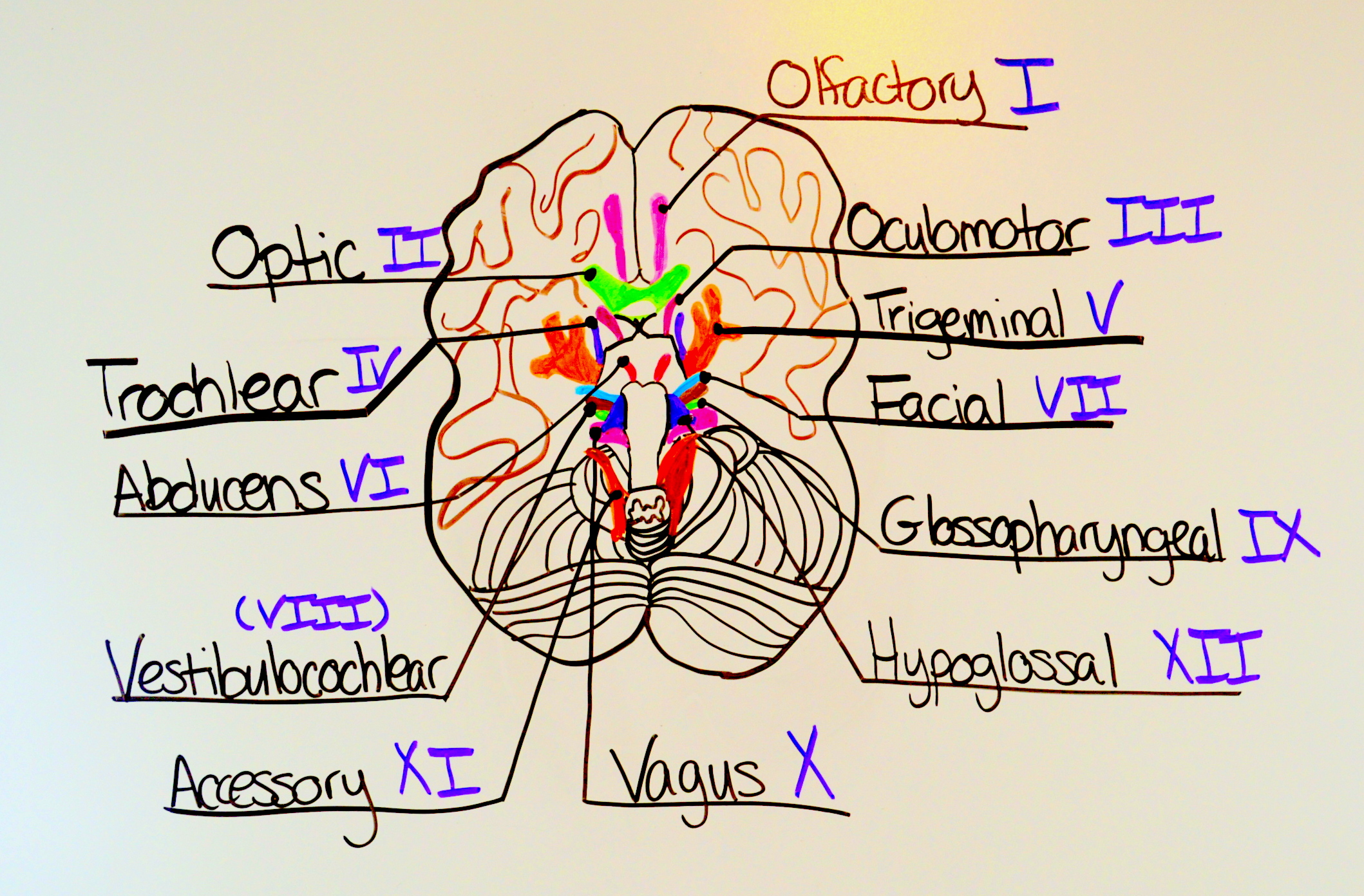- There are 12 pairs of cranial nerves that supply the structures in the Head, Neck, Thorax, and abdomen.
- A cranial nerve can be made up of a mixture of functions which are called modalities or may be made up of a single modality
- A modality is SENSORY, MOTOR, SPECIAL SENSORY, etc.



1.OLFACTORY NERVE (Cranial nerve l)
- Component- Sensory
- Function - Smell
- Origin - Olfactory receptor nerve cells
- Opening to the skull- Openings in the cribriform plate of the ethmoid.
2. OPTIC NERVE (cranial nerve ll)
- Component - sensory
- Function - vision
- Origin - Back of the eyeball
- Opening of the skull - Optic canal
3.OCCULOMOTOR NERVE (Cranial nerve lll)
- Component- Motor
- Functions -
- Raises upper eyelid
- Turns eyeball upward, downward and Medially
- Constricts pupil
- Accommodates the Eye
- Origin - Anterior surface of the midbrain
- Opening of the skull - Superior orbital fissure
4.TROCHLEAR NERVE (Cranial nerve lV)
- Component - Motor
- Function- Assisting in turning eyeball downward and laterally
- Origin - Posterior surface of the midbrain
- Opening to the skull - Superior orbital fissure
5.TRIGEMINAL NERVE (cranial nerve V)
V1. Ophthalmic nerve
V2. Maxillary nerve
V3.Mandibular nerve
V1. Ophthalmic nerve
- Components - sensory
- Functions -
- Cornea
- Skin of forehead
- Scalp
- Eyelids and Nose
- Mucous membranes of paranasal sinuses and nasal cavity.
- Origin - anterior aspect of the pons
- Opening of the skull - Superior orbital fissure

V2. Maxillary nerve
- Components- Sensory
- Functions -
- The skin of the face over the maxilla
- Teeth of the upper jaw
- The mucous membrane of the nose, the maxillary sinus, and the palate
- Origin - anterior aspect of the pons
- Opening to the skull - Foramen ovale
V3. Mandibular nerve
- Components - accessory motor
- Function -
- Muscles of mastication
- Mylohyoid
- Anterior belly of digastric
- Tensor veli palatine
- Tensor tympani
- Origin- anterior aspect of the pons
- Opening to the skull - Foramen Rotundum
6.ABDUCENT NERVE (cranial nerve Vl)
- Component - Motor
- Function - Lateral rectus muscle turns eyeball laterally
- Origin - Medulla oblongata
- Opening to the skull - Superior orbital fissure
7.FACIAL NERVE (cranial nerve Vll)
- Component - Mixed
- Functions -
(I) MOTOR
- Muscles of the face and scalp
- Stapedius muscle
- Posterior belly of digastric
- Stylohyoid muscles
- Taste from anterior 2/3rd of the tongue, from the floor of the mouth and palate.
- Component - Sensory
- Function -
- Vestibular - Saculae, Saccule , Semicircular canals- Position of the head.
- Cochlear - Organ of Corti - Hearing
- Origin - Medulla oblongata
- Opening to the skull- Internal acoustic meatus
9.GLOSSOPHARYNGEAL NERVE (cranial nerve lX)
- Component - Mixed
- Function -
(I) Motor
- Stylopharyngeus muscle- assists swallowing
(ii) Sensory
- General sensation and taste from posterior 1/2 of the tongue and pharynx.
- Cortis sinus and carotid body.
(iii) Secretomotor
Parotid gland
- Origin: Medulla Oblongata
- Opening to the skull: Jugular Foramen
10.VAGUS NERVE( Cranial nerve X)
- Component - Motor
- Function
- Heart and great thoracic blood vessels
- Larynx, Trachea, Bronchi, and lungs
- Alimentary tract from the pharynx to the splenic flexure of the colon
- Liver, kidney, Pancreas
- Origin - Medulla Oblongata
- Opening to the skull - Jugular foramen
11.ACCESSORY NERVE( cranial nerve Xl)
- Component-Motor
- Function
(I) cranial root
- Muscles of the soft palate
- muscles of pharynx
- muscles of larynx
(ii) Spinal root
- Sternocleidomastoid
- Trapezius muscle
- Origin - Medulla oblongata
- Opening to the skull - Jugular foramen
12.HYPOGLOSSAL NERVE(Cranial nerve Xll)
- Component - Motor
- Functions- Muscles of the tongue
- Origin- Medulla oblongata
- Opening to the skull- Hypoglossal canal
Comments
Post a Comment